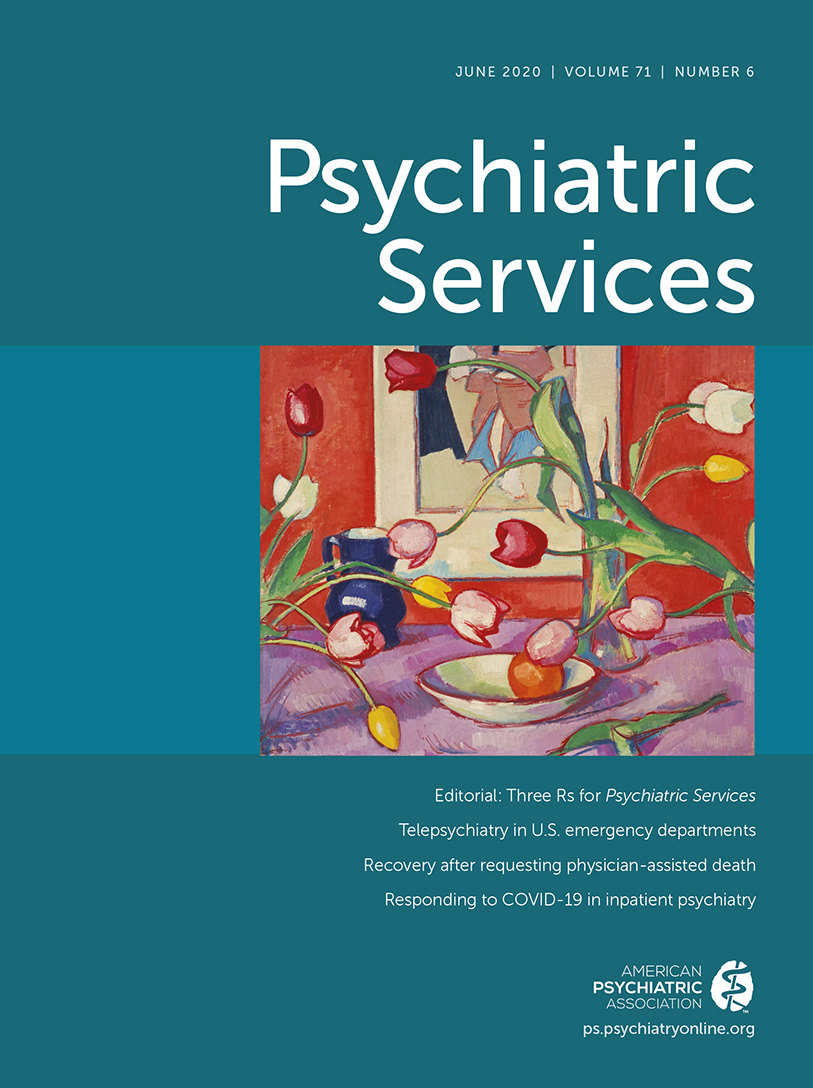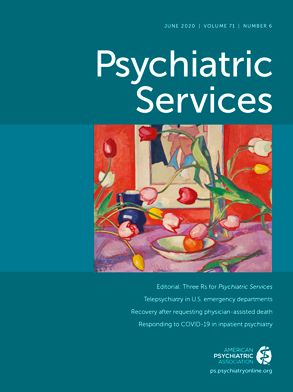In recent decades, psychiatric services have become increasingly difficult to access (
1) because of a shortage in mental health professionals (
2) and a decrease in dedicated beds (
3). With no other services to turn to, many experiencing mental health crises have no other option than to receive care in the emergency department (ED) (
4). As hospital and community psychiatric services have been reduced, EDs have seen increasing numbers of psychiatric visits and increased ED boarding of psychiatric patients awaiting bed placement (
4). Overall, about 13% of U.S. ED visits involved a diagnosis related to a mental health or substance abuse condition, or both, in 2007 (
5). Between 2007 and 2011, ED visits due to mental health conditions increased by 15% (
6). Frequent ED use for any reason has also been linked with poor mental health (
7). Psychiatric patients often wait much longer in the ED than do nonpsychiatric patients, and during this time, patients receive limited care as they wait for placement (
8,
9). EDs must balance the needs of all patients with limited resources, and an increase in visits can result in ED crowding, which can negatively affect the outcomes of all patients (
1,
10).
A recent innovation to help mitigate the dearth of psychiatric services available in the emergency setting is the implementation of telepsychiatry in EDs (
11–
14). In this study, we define ED telepsychiatry as the receipt of telemedicine services, using various telecommunications methods, for the evaluation of ED patients who may require mental or behavioral health care. With telepsychiatry, providers can evaluate patients remotely, thus making psychiatric services more accessible, even to patients located in rural, underserved areas (
15,
16). Despite the potential of telepsychiatry, there have not been any nationally representative studies regarding trends in telepsychiatry use and application in EDs. The objective of this study was to investigate the prevalence and application of telepsychiatry in general EDs in the United States.
Discussion
Our national investigation into the understudied topic of ED telepsychiatry yielded new information regarding the prevalence and clinical applications of telepsychiatry in emergency settings. Through our national survey, 2016 NEDI-USA, we found that 20% of U.S. EDs received some form of telepsychiatry, and these respondents were more likely to be EDs with higher annual visit volumes, rural location, and a CAH designation (
Table 2). Furthermore, in the 2017 ED Telepsychiatry Survey, we found that 59% of 95 EDs receive telepsychiatry as their only form of emergency psychiatric services. Telepsychiatry was most frequently used to assist EDs in admission or discharge decisions (80%) and transfer coordination (76%).
Nationally representative research on characteristics of ED telepsychiatry is very limited. The California Health Care Foundation examined seven ED telepsychiatry service programs as case studies (
28). Four of the programs provided services through a hospital system or from large academic hospitals to surrounding sites (both affiliated and unaffiliated). Two of the programs were provided through private, for-profit companies, and one program was provided through the state department of mental health. These findings parallel the range of providers reported in this study. Additionally, two programs noted increased psychiatric knowledge among ED physicians after implementation of telepsychiatry and thus reduced requests for consultation later on. This parallels the 11% of EDs in this study that reported using ED telepsychiatry for staff education.
Although research on the prevalence and characteristics of ED telepsychiatry is limited, there have been investigations into the effectiveness of telepsychiatry with favorable ED outcomes. Such research is vital in understanding how ED telepsychiatry may or may not work as an alternative to traditional psychiatric emergency services, considering that telepsychiatry was the only option for 59% of EDs. Two studies examining the usefulness of ED telepsychiatry in pediatric populations found that satisfaction among patients, parents, and providers as well as clinical outcomes after telepsychiatry assessment were similar to those for patients who received face-to-face psychiatric care (
29,
30). Pediatric telepsychiatry also reduced costs and ED lengths of stay (
30). Similar outcomes were seen in a statewide ED telepsychiatry program in which telepsychiatry patients were more likely to receive follow up, were less likely to be admitted to an inpatient setting at their ED visit, had a shorter ED length of stay, and had lower overall 30-day inpatient costs (
31).
Another study that examined the agreement between telepsychiatry assessment and face-to-face assessment of 73 ED psychiatric patients found there were no significant differences between evaluation methods (
32). Since more than half of the EDs surveyed in this study use telepsychiatry for diagnosis of psychiatric conditions, consistency in telepsychiatry evaluations is essential.
As the United States continues to face a deficit of available psychiatric services, EDs will likely continue to see high volumes of psychiatric patients in need of such services (
1,
2). General EDs in the United States are innovating to address this challenge. This is particularly true for EDs with PECCs and EDs in rural or CAH settings, as the NEDI-USA survey found that sites receiving telepsychiatry were more likely to have these characteristics. We hypothesize that, since a PECC’s role includes facilitating improvements in pediatric emergency care, this quality improvement initiative may encourage the installation of telemedicine services (
19)—or vice versa. The results showing that EDs receiving telepsychiatry were more likely to be rural are consistent with regional data showing that rural New England EDs were more likely to receive telemedicine services (in any form) (
27). Previous research has also shown a rapid growth in telepsychiatry use among rural Medicare beneficiaries (
33). For rural EDs that have not adopted telepsychiatry but lack the availability of psychiatric consultations, many providers are comfortable with the concept of telepsychiatry (
34). ED telepsychiatry is frequently implemented as a solution to expand psychiatric services in the midst of major workforce constraints, especially in rural and CAH settings. As telepsychiatry receipt becomes more common, nationally representative research is integral to the future investigation of patient outcomes, quality of care, and overall cost-effectiveness.
EDs receiving telepsychiatry were less likely to be autonomous FSEDs or located in an HPSA for mental health providers. Although satellite FSEDs may receive telepsychiatry services through parent hospitals, many autonomous FSEDs are run by for-profit entities, and the services they receive may be heavily dictated by the company (
35). It is unclear why EDs receiving telepsychiatry were less likely to be in an HPSA for mental health providers, but we hypothesize that it is indicative of the overall mental health professional shortage. For these EDs, telepsychiatry services through nearby hospitals may be nonexistent. Additionally, the receipt of telepsychiatry from out-of-state providers may be hindered by state policies that strictly regulate telemedicine services.
As shown in
Table 3, a small proportion (16%) of EDs did not receive telepsychiatry 24/7/365. Of these EDs, six reported telepsychiatry as their only form of psychiatric emergency services. More research needs to be conducted to better understand the reasons for these lapses in service and how staffing, reimbursement, and other factors play a role.
In many EDs, there is limited delivery of mental health care for psychiatric patients during the boarding process (
1,
5). As patients wait for placement, the delay in receiving care is extended. The use of telepsychiatry to assist with inpatient placement could alleviate ED crowding in several different ways, from helping ED physicians understand the difference between emergent and nonemergent cases to securing inpatient psychiatric beds more effectively (
28–
32).
In addition to ED patient flow, 56% of EDs reported using telepsychiatry for diagnosis of psychiatric conditions, and 45% used it for treatment of psychiatric conditions, which indicates that, for many, telepsychiatry may allow for earlier delivery of care. This is important for uninsured psychiatric patients who have limited options for inpatient care and, thus, higher boarding times (
36).
These uses are somewhat different than that of pediatric telemedicine receivers (
20), where 75% used such services for treatment of conditions. Although most literature on ED telepsychiatry focuses on the delivery of psychiatric care via telecommunications, our study suggests that ED psychiatric treatment may be less of a priority, as telepsychiatry is more often used for informed triage of patients through assistance with admission and discharge decisions and transfer coordination. Future inquiries may investigate barriers to treatment via telepsychiatry and ways to combat such barriers.
This study had several potential limitations. For logistical reasons, the NEDI-USA survey asked about telepsychiatry receipt in 2016, whereas the follow-up survey investigated 2017 telepsychiatry receipt. Even so, this enabled us to further confirm ED telepsychiatry receipt for both 2016 and 2017. Although the response rates were more than 80% for both surveys, the smaller sample size for the second survey limited our ability to perform more extensive analyses. Because of the cross-sectional nature of this study, causal inferences were not possible. Furthermore, all data were self-reported, which may have introduced information bias. To minimize this possibility, we targeted the surveys to ED directors. We estimate that over 80% of respondents to the 2016 NEDI-USA survey were ED directors or in ED leadership (i.e., individuals who would definitely know about the status of telepsychiatry in their ED). For the 2017 ED Telepsychiatry Survey, all respondents were ED directors or in ED leadership. Additionally, the NEDI-USA database includes all 24/7/365 EDs available to the general public. As stand-alone PES do not meet these criteria, such entities were not included. We believe that this was appropriate for this study, in which the objective was to understand the prevalence and application of telepsychiatry in general EDs in the United States.


